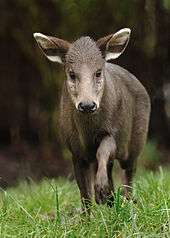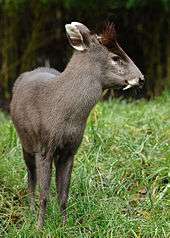Tufted deer
The tufted deer (Elaphodus cephalophus) is a small species of deer characterized by a prominent tuft of black hair on its forehead and fang-like canines for the males.[2] It is a close relative of the muntjac, living somewhat further north over a wide area of central China northeastern Myanmar. Suffering from overhunting and habitat loss, this deer is considered near-threatened. It is the only member of the genus Elaphodus. It is restricted to forested mountain habitat up to 4500 m above sea level, making study difficult.
| Tufted deer | |
|---|---|
| Tufted deer at the Columbus Zoo and Aquarium | |
| Scientific classification | |
| Kingdom: | Animalia |
| Phylum: | Chordata |
| Class: | Mammalia |
| Order: | Artiodactyla |
| Family: | Cervidae |
| Subfamily: | Cervinae |
| Genus: | Elaphodus Milne-Edwards, 1872 |
| Species: | E. cephalophus |
| Binomial name | |
| Elaphodus cephalophus Milne-Edwards, 1872 | |
Subspecies
Four subspecies of the tufted deer are recognized, with one having doubtful taxonomic status:[1]
- E. c. cephalophus – the largest subspecies, brownish coat, found in southwestern China and northeastern Myanmar.
- E. c. michianus – has a relatively narrow snout, found in southeastern China.
- E. c. ichangensis – has a relatively broad snout, with a grey-brown coat, found in Central China.[3]
- E. c. forciensus – doubtful subspecies, distribution unclear.[1]
Description

The tufted deer is similar to a muntjac in appearance, but the longer necks and legs give it a slightly leaner appearance. The coat is coarse with short and stiff hairs, being almost black in the winter and chocolate brown in the summer. The lips, tip of the ears, and the underside of the tails are white. A tuft of horseshoe-shaped hair is present on the forehead and upper neck, being brown to black, and can be up to 17 centimetres (6.7 in) long.
Perhaps the most striking feature of this deer is the fang-like canines in the males of the species. These can grow up to 2.6 cm (1.0 in) long, or longer in rare cases.[4]
The tufted deer is a small deer, but still larger than most muntjac species. It stands at 50–70 centimetres (20–28 in) at the shoulder, and the weight varies from 17 to 30 kilograms (37 to 66 lb).[5] The tail is short at around 10 cm (3.9 in). The antler is only present in males and is extremely short, almost hidden by its long tuft of hair.[3]
Habitat and distribution

The tufted deer is found mainly in China, where it occurs in the south from eastern coast to eastern Tibet. It is absent from the extreme south of the country. There are old records of this species in northeastern Myanmar, but recent surveys failed to find any, possibly due to the lack of surveys on the preferred habitat.[1]
The tufted deer inhabits high, damp forests at 500–4,500 metres (1,600–14,800 ft) above sea level, close to the tree line. It is found in both evergreen and deciduous forests with extensive understory and nearby freshwater supply. The availability of salt licks is also a positive factor to the presence of this animal. This deer is able to withstand minor human disturbances, and is occasionally found in cultivated lands.[3]
Behavior and reproduction
The tufted deer is mainly solitary or found in pairs. It is crepuscular and travels in fixed routes about its territory, which is vigorously defended by the males. It is a timid animal and prefer places with good cover, where it is well camouflaged. It can be easily disturbed and, when alarmed, it will let out a bark before fleeing, moving in cat-like jumps.[6]
The mating season occurs between September and December, during which the loud barks males make could be easily heard. The gestation period lasts about 6 months and a litter of 1–2 is born in early summer. The young becomes sexually mature at the age of 1–2 years, and could live up to 10–12 years in the wild.[3][6]
Threats and conservation
Surveys from 1998 put the estimated population around 300,000–500,000 individuals, though a substantial, ongoing decline is almost certain. Overharvesting of large animals in China is a serious threat not only to this species. The hide of this deer is a fairly high-end textile material, especially after the vigorous conservation efforts made on other more endangered species. Habitat loss is also an issue in this rapidly developing country. In China, this species is listed as provincially protected species in many places, but it is not protected by the national law. It occurs in a number of protected areas. More study needs to be done on this poorly known species for efficient protection.[1]
The tufted deer is part of the yellow species survival plan program by the association of zoos and aquariums, because it cannot maintain 90% gene diversity for 10 generations. To prevent gene diversity to continue dropping the program plans to work on ex situ [7] populations by increasing the number of exhibit places in zoos and making sure that animals can breed. Prior to this the tufted deer population was also decreasing in captivity due to lack of interest in the species even though captivity greatly help conserve this species by facilitating interbreeding and gene diversity.
References
- R. B. Harris (2008). "Elaphodus cephalophus". IUCN Red List of Threatened Species. 2008. Retrieved 10 April 2012.CS1 maint: ref=harv (link)
- Leslie Jr, David M., Dana N. Lee, and Richard W. Dolman. "Elaphodus cephalophus (Artiodactyla: Cervidae)." Mammalian Species 45.904 (2013): 80-91.
- Tufted Deer (In Simplified Chinese)
- Ultimate Ungulate
- Wilson & Mittermeier (2011). Handbook of the Mammals of the World vol. 2, p. 409. ISBN 978-84-96553-77-4
- ARKive
- Panyaboriban, Saritvich; Singh, Ram; Songsasen, Nucharin; Padilla, Luis; Brown, Janine; Reed, Dolores; Techakumphu, Mongkol; Pukazhenthi, Budhan (1 September 2016). "Reproductive seasonality and sperm cryopreservation in the male tufted deer (Elaphodus cephalophus)". Theriogenology. 86 (4): 914–923. doi:10.1016/j.theriogenology.2016.03.014. PMID 27125695.
